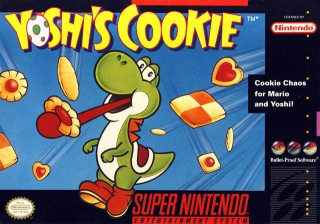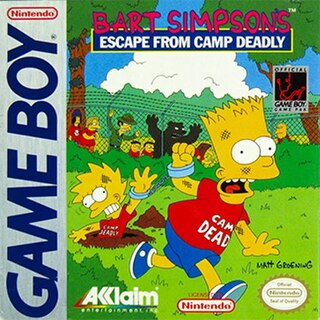
A platformer is a sub-genre of action video games in which the core objective is to move the player character between points in an environment. Platform games are characterized by levels with uneven terrain and suspended platforms of varying height that require jumping and climbing to traverse. Other acrobatic maneuvers may factor into the gameplay, such as swinging from vines or grappling hooks, jumping off walls, gliding through the air, or bouncing from springboards or trampolines.

Dr. Mario is a 1990 puzzle video game developed and published by Nintendo for the Nintendo Entertainment System, Famicom, and Game Boy. It was produced by Gunpei Yokoi and designed by Takahiro Harada. The soundtrack was composed by Hirokazu Tanaka.

Yoshi's Cookie is a 1992 tile-matching puzzle video game developed by Tose and published by Nintendo for the NES and Game Boy platforms in 1992. A Super NES version was released the following year, developed and published by Bullet-Proof Software.
Andrew Nicholas Oliver and Philip Edward Oliver, together known as the Oliver Twins, are British twin brothers and video game designers.
Ninja Gaiden is a media franchise based on action video games by Tecmo featuring the ninja Ryu Hayabusa as its protagonist. The series was originally known as Ninja Ryukenden in Japan. The word "gaiden" in the North American Ninja Gaiden title means "side story" in Japanese. The original arcade version, first two Nintendo Entertainment System games and Game Boy game were released as Shadow Warriors in PAL regions. As of 2008, the series has shipped over 7.7 million copies.

Castlevania II: Simon's Quest is a 1987 action role-playing game developed and published by Konami. It was originally released in Japan in 1987 for the Famicom Disk System, and in North America in 1988 for the Nintendo Entertainment System. It is the second Castlevania game released for the NES, following the original Castlevania (1986). Set seven years after the events of the first installment, the player once again assumes the role of vampire hunter Simon Belmont, who is on a journey to undo a curse placed on him by Dracula at the end of their previous encounter. Dracula's body was split into five parts, which Simon must find and bring to the ruins of Castle Dracula in order to defeat him. The game deviates from the traditional platforming of its predecessor, incorporating role-playing and open world elements.

Mortal Kombat II is a fighting game originally produced by Midway for the arcades in 1993. It was ported to multiple home systems, including MS-DOS, Amiga, Game Boy, Game Gear, Sega Genesis, 32X, Sega Saturn, Super Nintendo Entertainment System, and PlayStation only in Japan, mostly in licensed versions developed by Probe Software and Sculptured Software and published by Acclaim Entertainment.

Fantastic Dizzy is a 1991 video game developed by Codemasters. It is part of the Dizzy series. It was published on several platforms, including Mega Drive/Genesis, Master System, Game Gear, Nintendo Entertainment System, Amiga, and MS-DOS.

Bart Simpson's Escape from Camp Deadly is a 1991 platform video game for the Game Boy. Developed by Imagineering, it was published by Acclaim Entertainment in North America and Europe in 1991. The game was released in Japan in 1993. In Bart Simpson's Escape from Camp Deadly, the player controls Bart from the television series The Simpsons as he escapes from an unpleasant summer camp run by ruthless counselors. The plot is similar to that of The Simpsons episode "Kamp Krusty", although the game was released nearly a year before that episode aired. Critics gave the game mixed to negative reviews.

The Simpsons: Bart vs. the Space Mutants is a platform video game, the second based on the animated television series The Simpsons. It was released in 1991 for the Nintendo Entertainment System, Amiga, Amstrad CPC, Atari ST, Commodore 64, and ZX Spectrum, and in 1992 for Sega Genesis, Master System and Game Gear. It was published by Acclaim Entertainment on consoles and Ocean Software on computers, and developed by Imagineering and Arc Developments. In the game, the player controls Bart Simpson through five levels as he tries to ruin the aliens' plan to take over the world. Video game critics have given Bart vs. the Space Mutants mixed reviews, with criticism directed at the difficulty of the game, partly caused by restricted controls.

The Simpsons: Bart's House of Weirdness is a platform video game published by Konami on January 1, 1992 for MS-DOS. Developed by Distinctive Software, it is based on the Simpsons franchise and features many aspects from the series. In the game, the player controls Bart as he escapes from the Simpsons' house after being grounded by his parents. On his adventures throughout town, Bart is equipped with various weapons that are used to fend off enemies and animals. Bart's House of Weirdness does not have a wide fan base because it was only released for DOS, but the early reviews of the game were positive, at least in terms of graphics and sound.

The Simpsons: Bart vs. the Juggernauts is an action video game released in 1992 for the Game Boy. It was developed by Imagineering and published by Acclaim. The plot stars Bart from The Simpsons in a game show based on American Gladiators, in which he has to compete in challenges to earn money. Critics gave The Simpsons: Bart vs. the Juggernauts average reviews.

Krusty's Fun House is a puzzle video game based on the animated sitcom The Simpsons.

The Simpsons: Bart & the Beanstalk is a platform game released in February 1994 for the hand-held console Game Boy. It was developed by Software Creations and published by Acclaim Entertainment, and is based on the animated television series The Simpsons. The game is a parody of the fairy tale "Jack and the Beanstalk"; a large beanstalk grows far up into the sky outside the home of Bart Simpson, whom the player controls. Bart climbs the beanstalk all the way to the top and adventure ensues. Bart & the Beanstalk has received mixed to negative reviews from critics.

The Simpsons: Bartman Meets Radioactive Man is a 1992 platform game published by Acclaim for the Nintendo Entertainment System and Game Gear. Developed by Imagineering, the side-scrolling game features Bart Simpson on a comic book quest to rescue his kidnapped idol, superhero Radioactive Man. Bartman Meets Radioactive Man received generally negative reviews from critics, with criticism being directed at the gameplay control.

There have been several video games based on the 1991 film Hook. A side-scrolling platform game for the Nintendo Entertainment System (NES) and Game Boy was released in the United States in February 1992. Subsequent side-scrolling platform games were released for the Commodore 64 and the Super Nintendo Entertainment System (SNES), and an arcade beat ‘em up by Irem later in 1992, followed by versions for the Sega CD, Sega Genesis, and Sega's handheld Game Gear console in 1993.

The Simpsons Game is a 2007 platform game based on the animated television series The Simpsons made for the Nintendo DS, Wii, Xbox 360, PlayStation 2, PlayStation 3 and PlayStation Portable. The game was published and distributed by Electronic Arts. It was released in North America in October 2007 and worldwide in November 2007, a few months after The Simpsons Movie. It features an original storyline, not related to the movie, written by Simpsons writers Tim Long and Matt Warburton. In the self-referential plot, the family discovers that they are forced to participate in another The Simpsons video game. Similar to the show, the game pokes fun at popular culture, many other video games, and Electronic Arts, its publisher.















